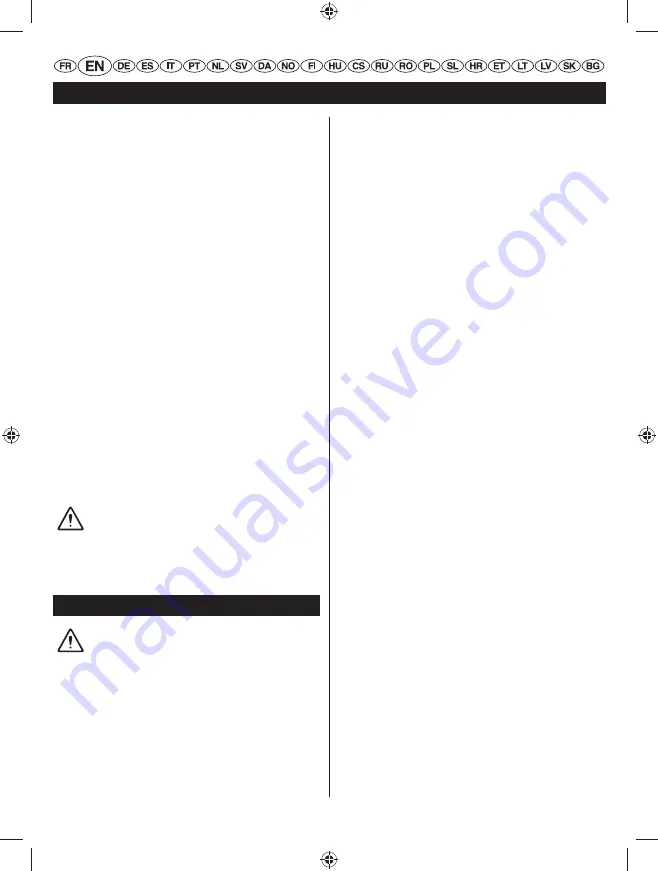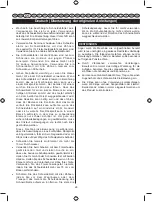
English (Original instructions)
as shown to extend more line. Take care not to ‘crash’ it
against a hard surface.
OPERATING THE BRUSHCUTTER (Fig. 5)
Hold the brushcutter with the right hand on the rear handle
and the left hand on the front handle.
Keep a firm grip with both hands while in operation.
Brushcutter should be held at a comfortable position with
the trigger handle about hip height. Maintain your grip and
balance on both feet. Position yourself so that you will
not be drawn off balance by the kick-back reaction of the
cutting blade.
Adjust the shoulder strap to position the brushcutter at
a comfortable operating position and to assure that the
shoulder strap will reduce the risk of operator contact
with the blade.
Exercise extreme caution when using the blade
with this unit. Blade thrust is the reaction which
may occur when the spinning blade contacts
anything it cannot cut. This contact may cause
the blade to stop for an instant, and suddenly
“thrust” the unit away from the object that was hit.
This reaction can be violent enough to cause the
operator to lose control of the unit. Blade thrust may
occur without warning if the blade snags, stalls or binds.
This is more likely to occur in areas where it is difficult to
see the material being cut. For cutting ease and safety,
approach the weeds being cut from the right to the left.
In the event that an unexpected object or woody stock is
encountered, this could minimise the blade thrust reaction.
CUTTING TECHNIQUE - BLADE (Fig. 8)
WARNING
Extreme care must be taken when using blades
to ensure safe operation. Read the safety
information for safe operation using the blade,
refer to “Specific Safety Rules for Brushcutter
and Blade Use” earlier in this manual.
MAINTENANCE
WARNING
Use only original manufacturer's replacement
parts, accessories and attachments. Failure to
do so can cause possible injury, poor perfor-
mance and may void your warranty.
■
The cutting attachment must not rotate in idle mode.
If this requirement is not satisfied, the clutch has
to be adjusted or the machine needs an urgent
maintenance by a qualified technician.
■
You may make adjustments and repairs described
here. For other repairs, have the trimmer serviced by
an authorized service agent.
■
Consequences of improper maintenance may
include excess carbon deposits resulting in loss of
performance and discharge of black oily residue
dripping from the silencer.
■
Make sure all guards, straps, deflectors and handles
are properly and securely attached to avoid the risk of
personal injury.
LINE REPLACEMENT (Fig.9)
■
Ensure the unit is in the off position
■
Remove the spark plug lead, to prevent accidental
starting.
■
Use 2.4mm diameter monofilament string.
■
Cut one piece of string approximately 6.0m in length
■
Rotate knob on string head until line on knob aligns
with arrows on top of string head.
■
Insert one end of string into eyelet located on the
side of the string head and push until string comes
out through eyelet on the other side. Continue to
push string through the string head until the middle
section of the string is inside the string head and
string outside the string head is evenly divided on
each side.
■
Rotate the knob on the string head clockwise to wind
the string
■
Wind the string until approximately 20cm remains
protruding from the string head.
BLADE PROTECTOR (Fig. 10)
Always place the blade protector on the blade when the
unit is not in use. The blade protector has clips round the
edges to snap over the blade and keep it in place. Wear
gloves and be cautious when handling the blade.
NOTE:
Always remove the blade protector before
using the unit. If not removed, the blade protector could
become a thrown object as the blade begins to turn.
CLEANING THE EXHAUST PORT AND
SILENCER
Depending on the type of fuel used, the type and amount
of oil used, and/or your operating conditions, the exhaust
port and silencer may become blocked with carbon
deposits. If you notice a power loss with your petrol
powered tool, a qualified service technician will need to
remove these deposits to restore performance.
SPARK ARRESTOR
It is recommended to clean or replace the spark arrestor
every 25 hours or yearly to ensure proper performance
of your product. Spark arrestors may be in different
locations depending on the model purchased. Please
contact your nearest service dealer for the location of the
spark arrestor for your model.
ATTACHING THE STORAGE HANGER
Please refer to Fig.11.
19
Summary of Contents for RBC26SESB
Page 28: ...LJ I LJ H...
Page 49: ...LJ D LJ E LJ E 5HHO DV 70 LJ F 5HHO DV 70 5HHO DV 70 RU FXUYHG VKDIW 5HHO DV 70 LJ F PP P FP...
Page 50: ...LJ G PP PP LJ I LJ H PP PP...
Page 195: ...145 6 7 5 8 9 2 4 6 0 20 10...
Page 197: ...147 I 10 15 9 CHOKE 3 2...
Page 198: ...148 1 2 3 4 5 1 2 3 4 5 1 2 1 2 1 2 3 1 2 2 3...
Page 286: ...235 6 7 5 8 4 9 2 4 6 0 20 10...
Page 287: ...236 25 11 12 13 Champion RCJ 6Y 0 63 mm 1 2 3 4 5 1 ISO 2...
Page 288: ...237 I 10 15 9m 20160411v1...
Page 289: ...238 1 2 3 4 5 1 2 3 4 5 1 2 1 2 1 2 3 1 2 3...
Page 316: ...3...
















































